汽车发展史-英文翻译
汽车发明过程英文作文
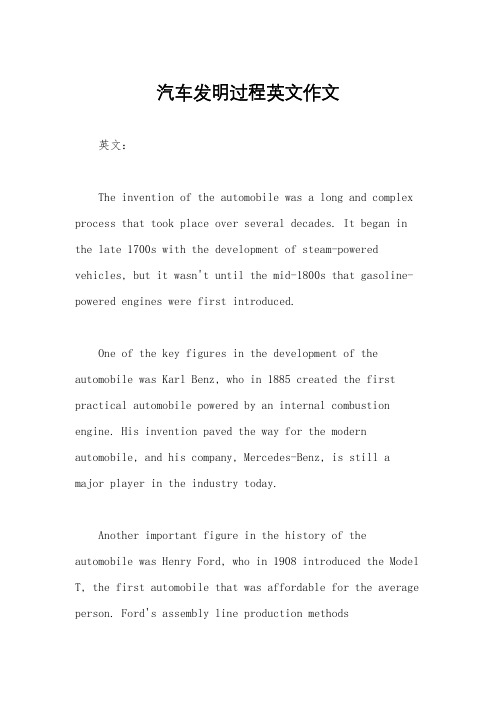
汽车发明过程英文作文英文:The invention of the automobile was a long and complex process that took place over several decades. It began in the late 1700s with the development of steam-powered vehicles, but it wasn't until the mid-1800s that gasoline-powered engines were first introduced.One of the key figures in the development of the automobile was Karl Benz, who in 1885 created the first practical automobile powered by an internal combustion engine. His invention paved the way for the modern automobile, and his company, Mercedes-Benz, is still a major player in the industry today.Another important figure in the history of the automobile was Henry Ford, who in 1908 introduced the Model T, the first automobile that was affordable for the average person. Ford's assembly line production methodsrevolutionized the manufacturing process and made automobiles accessible to millions of people.Over the years, automobiles have continued to evolve and improve. Today, we have electric and hybrid cars, self-driving cars, and cars that can communicate with one another. The automobile has become an essential part of modern life, and it's hard to imagine a world without them.中文:汽车的发明是一个漫长而复杂的过程,历时几十年。
中国汽车工业发展中英文对照外文翻译文献

中英文资料外文翻译外文翻译The mercerized and internationalized backgroundAt present,under the mercerized and internationalized background,how to strengthen the independent development ability of our country’s auto industry has become the urgent problem to be solved.This article,by referring to the experience of developed countries of automobile industry in implementing the industrial policy and comparing the two regulations made in 1994 and 2OO4 about independent intellectual property right in the industrial policy,has put forward policy recommendations of supporting independent development of our country’s auto industry.A brand based on market is promises for a product's capability, quality and service. Up to now, well-known automobile brands are accounting for two percent of two hundred far famed brands in all country. Meanwhile, after going into WTO, a great set of foreign automobile enterprises possessing good quality, favorable capability, knight service will enter into our country and bring a fire-new idea of brand for our domestic consumers. No doubt, that will not only greatly impact on our domestic automobile enterprises, which don't have the capability of independent exploitation and the consciousness of brand cultivation, but also affect development of automobile industry. So, during the crucial period, our country needs urgently brands of great competitive power, which can drive and prompt development of automobile industry.The paper, starting with the analysis of brand and combining with the theory of strategy management, regarding carmakers as object, depicts development panorama of domestic automobile industry and provides some simple thoughts about breeding and developing automobile brand in our country, through studying studying problems relating to automobile brand. It is the primary studying intention that upgrades core competency Of domestic automobile enterprises and impels development of automobile industry, recurring to putting forward some related tactics of breeding and developing automobile brand in our country. The paper's meaning consists two points: the first, it makes enterprises attach importance to automobile brand in consciousness and know it afresh;the second, it advances some operational tactics by demonstration analysis, which can be used for reference by enterprises and industry.Research methods used in the paper are primarily demonstration analysis and comparison analysis. Anticipative research fruits of the paper involve: (1) seedtime and actuality analysis of automobile brand in our country; (2) mode-comparison of automobile brand in different countries;(America, German, Japan, Korea); (3) key factors of affecting our automobile brand development;(4) tactics and countermeasures of cultivating automobile brand. Innovations of the paper rest with: (1) research content, i.e. havinga all-around research of breeding automobile brand and coming into being strategy system;(2) research purpose, i.e studying how to forge competitive automobile brand can drive industry development; (3) research angle, i.e. knowing and analyzing automobile industry in virtue of brand.Referred to the main indexes about evaluating national competitive ability, which is the commonly used method in the international society, this thesis aims at analyzing and evaluating the international competitive ability of Chinese automobile industry in a scientific and objective way. Compared with those industries in some developed countries, domestic automobile industry is relatively frail and has a very long way to go. This thesis illustrates the history of Chinese automobile industry ever since the foundation of new China, analyzes in detail its important role in national economy, and the opportunities and threats it meets after china entrance WTO. This thesis draws a whole picture about domestic automobile industry from three aspects: products, corporations and industries. Considering the history and actuality of domestic automobile industry, this thesis collects and analyzes groups of data about automobile industry both from domestic and international. A lot of work was made in quantitative and qualitative analysis from all sides. Based on this, this thesis drew a conclusion about evaluating the international competitive ability of Chinese automobile industry, found out the advantages and disadvantages about this industry. In the end of this thesis, some ideas and advice are put forward.Welfare Evaluation of Trade Protection--The automobile industry of post world war 2 in JapanSocial welfare is one of the key standards in evaluating the effects of government policies for both economists and government. In this thesis, having compared and analyzed trade protectionists, i.e. quota, tariff and other non-tariff barriers in their effects on social welfare, specific evaluation and suggestion are given in the case of the autoindustry protection in post World War 2 Japan, so to shed light on the auto protection policies should be taken in China today. Here, consumer’ surplus and Ohyama Welfare Standard are selected in evaluating social welfare.The automobile industry in Post World War 2 in Japan is picked for two reasons. Firstly, the auto industry in China today is in a very similar situation as that of Japan used to be while Japan was a new member of GATT. Secondly, regarded as one of the most successfully developed industries under protection, the auto industry in Japan has some precious experiences worth studying.The article has four chapters. In chapter1,the definition of social welfare is given, and the necessary and sufficient condition for Pareto optimality, the Mashallian Consumer Surplus, Hicksian consumer surplus and Ohyama Social Welfare Standard are discussed in detail the auto industry. In Chapter 2, according the scale and protection on Japan from 1945-1979 is divided into four periods: government domination period, Quota Period and low-tariff Periods: government domination period, Quota Period, High-tariff Period and low-tariff Period, where the protect policies are evaluated respectively by their effects on social welfare. Chapter 3 explores the US-Japan trade friction in auto industry in 1980s and sheds light on the choice of various protectionists from the perspective of Political Economics. Chapter 4 concludes the whole thesis discussing some specific protection policies of Japan and drawing suggestion for China to effectively protect its own auto industry.Mini-car industry development in China is a successful example in the condition of Chinese market economy, it's always one of the important factor that propel the steady increase of auto market of China. Through about two decade development, the total amount of mini-car increased from 0.06% to 26.4% of total amount of auto all over the country now and the amount of produce and sale are up to 540,000 units. According to the challenge principle of "who is the best who is the winner" in the market, the number of the mini-car manufacturer decreased from early over one hundred to recent five.In this article,base on extensive data collecting and investigation, the mini-car developing and competing status of China, as well as the developing status (including enterprise, production ,market ,product, etc.) of Liuzhou Wuling Motors which is one of the five mini-car manufacturer are deeply analysed and studied .This article also discussed the competing environment that Liuzhou Wuling Motors faced, then provided the developing strategies.Since the later part of 1990, the economic benefits of CITIC Zhongyuan AutomobileCompany have been declining rapidly and the production management has also been on a sticky wicket, showing difference with an overall upward tendency to the corresponding period of the National Automobile Industry, which impelled this writer to make deeply careful researches on the strategy of development for the company.By reviewing the past of CITIC Zhongyuan Automobile Company, analyzing the influences on international & domestic external environments ever since China' s enter into WTO, analyzing the markets of the main products and the competitive opponents and analyzing the internal conditions such as the main problems faced by the company, this writer has separately made researches and probed into the strategies of development for CITIC Zhongyuan Automobile Company and the subordinate companies-Zhengzhou Nissan Automobile Co.,Ltd and Zhengzhou Light Truck Factory invested by CITIC Zhongyuan Automobile Company so as to try to find a feasible road which enables the cc叩any to break away from the disadvantageous situation and develop continuously as soon asPossible.With the entrance of 90th century, the international situation of automobile industry changed greatly. Due to the production surplus of international automobile industry, different countries competed fiercely to obtain the automobile market. Many companies adjust their developing strategy and speed the course of globalization to realize the scale-economy and get the new market. Merging and recombining become the symbol of automobile industry globalization.China, the biggest automobile consuming market in the world, has become the main field of many countries contesting. The Chinese automobile industry has developed for half century. Although china has get great achievements, as for scale or technique, China still drop behind. So how to improve the international situation and realize the modernization of China automobile industry is a basic mission.With the entrance of WTO, Chinese automobile industry faces three challenges: the first, after China entrances WTO, the government trade protection will be canceled. The second, with the economic development and standard of living improved, how to enlarge the consumer demanding? The third, with the automobile industry globalization, how to compete or cooperate with the MNC and build our effective developing strategy? And then we can develop our own auto industry and realize modernization. In the three challenges, the former two is normal and we can get many experiences from other countries. But the third is a real challenge. Other automobile developed countries have not faced this kind of situation. Expect for exactly estimation, we still need great innovation spirit.In the situation of entrance of WTO and globalization of automobile industrial competition, we try to analysis the Chinese automobile industry status quo, including the analysis of industrial structure, market analysis. Through the analysis we try to find out the questions in development strategy, government decision and enterprise management. Then we will analysis the questions and give the reasons. At the same time, we will the introduce the typical representatives of automobile developed countries and new developing countries about their developing strategy, including America, Japan, South Korea, and Mexico. We will conclude the advantages and experiences of above countries. On the base of that, we will combine the situation of Chinese automobile industry and the effecting analyzing of Chinese entrance of WTO. Then we will give out the advantages and potential advantages of Chinese automobile industry and bring forward the basic strategy of Chinese automobile industrial development. At last, we will give some advises about the developing strategy of Chinese automobile industry. These tactics include industrial policy improving, technique improving, competitive improving and cluster developing of Chinese automobile industry and technique innovation. This dissertation just discusses the Chinese automobile from a few tangles. It is not perfect, so I hope teachers can give me advice.Automobile industry is a traditional pillar industry in our country. Having developed 50 years, now the industry is still backward in products in comparison with that of western developed countries. Facing to economy globalization, someone has suggested that China should give up automobile industry and import the products from other countries directly, which can avoid wasting resources. This kind of viewpoint is lack of foresight. Automobile industry belongs to high and new-technology industries. Meanwhile, China has its large automobile market. Developing automobile industry will not only improve engineering level, but also drive other relevant industries. In addition, after China joining WTO (World Trade Organization), the automobile market will become a part of international market step by step. Basing on domestic market, we will develop our own intellectual property. At the same time, aiming at the demands of some developing countries, we will develop overseas markets. In this way, domestic automobile industry will be growing fast.In order to develop the automobile industry, we should find its disadvantages, get over influence of various disadvantages, seize every good chance, and exert our advantages. In this thesis, first, we stress on the impacts of economy globalization and WTO on Chinese automobile industry. Second, the thesis discusses many influence factors for developing Chinese automobile industry. Finally, the thesis analyzesopportunity, challenge and strategy of Chinese automobile industry.The course of the development of the automobile industry all over the world indicates that the automobile industry is very important to the national economy. The increasing proportion of distribution cost to sale price on the international automobile market shows that marketing plays an increasing role in raising the competitiveness of automakers. The trend of the international automobile market demonstrates thatAsia-especially china-will be the fastest growing market in the world. Although the national automobile industry has developed greatly in the past 50 years, it is still far behind the foreign competitors, especially in marketing after longtime ignoring marketing, domestic automarkers are lack of direct selling experience.In this thesis, the author analysed the 4P of marketing of the Chinese and foreign automarkers as well as the advantages and disadvantages of Chinese automobile industry and made some suggestions on how to improve the competitiveness of automobile enterprises after studied the management and administration of them.In order to convey the opinion systematically so that it may become more practicable, the construction of the thesis is arranged like this:Chapter One: Introduction. In this part, the author introduced the background, the focal point and the aim of writing the paper. The author also emphasized the importance of automobile industry to the national economy and the importance of marketing to automobile enterprises.Chapter Two: The author described the present automobile industry and the market all over the world through some examples. The influence on the national automobile industry after China joined WTO and the strategy for the development of the industry are given in this part as wellChapter Three: Close analysis and explanations of the strategy for price, products, patens and channels of distribution, and sales promotion are given after introduced the marketing strategy of automobile enterprises in both China and foreign countries.Chapter Four: The problems that exist in management and administration of national automobile industry are researched and the disparities in competitiveness between Chinese and foreign automobile industry are revealed. Reasons of these problems and disparities are also applied.Chapter Five: Conclusion proposals were put forward for improving the management and administration of automobile enterprises in China: adjust the concept of management, emphasize the importance of market segmentation and the study of consumer psychologyand consumer’s behavior, sensitiveness the reaction to market and extend the scope of service. Great importance is attached to the foundation and management of customer relationship.China's automotive industry has passed almost half a century and has evolved many basic circumstances and features of its own which will be the starting point or base for its further development. Full understanding of those circumstance and features is the prerequisite for us to analyze and study.In order to develop our automotive industry under new situation, we not only must roundly and objectively analyze the problems in us, but also must fully and correctly understand our actual and potential strengths. We should clearly recognize that although our automotive industry, which has experienced nearly fifty years of development including twenty years of reform and opening, has a long way to go comparing with the world level, it possesses many rare giant actual and potential strengths.After entering WTO our automotive industry has entered upon a new phase to cooperate and compete with multi-nationals under the background of globalization, and it will have to join the integration tide of global economy gradually. The trends of world automotive industry and the strategies of multi-nationals in China certainly will directly influence the strategic pattern of our automotive industry, and therefore they are the important part of the external environment of our automotive industry needed special attention. Great changes have taken place in the development conditions of our automotive industry since we entered WTO. At the end of protection interim period to automotive industry, the comprehensive effects of WTO including tariff concession, quota cancel, service trade opening and foreign capital policy regulation will display. The medium and high-class car and key components will come under obvious attack depends on not only the reduction of the protection degree, but also the increase of our international competitive power.Japan and Korea are all latecoming developed countries of automotive industry. After entering GATT, they persevered in adopting the vigorous policies to foster and train the self-developing capability and enhance the international competitive power. Then their automotive industry received unprecedented fast development and drove the whole national economy to be powerful and prosperous to a miracle. Although the international environment has been totally different and different countries differ greatly in their conditions, the experiences of Japan and Korea automotive industry during that period and driving effects of their automotive industry to their national economy will stillbe special historic significance to our automotive industry.Entering WTO let us enter upon a new e to cooperate and compete with multi-nationals featuring foreign companies but national treatment and domestic market but international competition. That is a severe challenge as well as a rare opportunity to our automotive industry. The great country and its big market are the most important strength of us. To take full advantage of the strength of great country and big market under the opening and competition environment should be the starting point for the development train of thought of our automotive industry under new economic background.Economic globalization droved by trade liberalization, investment liberalization and finance liberalization has been international background of our lives. Trade liberalization provides a more open and more liberal environment for the development of international trade. It is not only one of subject of modern international economic development, but also the trend of China's adjustment of her trade policy. Under economic globalization, advantage gained by a country depends on the magnitude of her international competitive power of industry. As China as concerned, the influence factors and basic status of her international competitive power of industry have their own characteristics.This paper analyses the international competitive power of China's industry under the background of trade liberalization. Firstly, it explains the historical and current background of the subject, presents the thinking way, the analysis methods, the frame and the innovation of this paper. Secondly, the theories about trade liberalization and international competitive power of industry are presented, the author simply describes the process and the achievements of trade liberalization and introduces something about trade liberalization in China, illustrates mainly the concept, the meaning, the correlative theoretical basis and the measure methods of the international competitive power of industry. Then, in the fourth chapter, Taking example for China's automobile industry, the paper analyses the international competitive power of automobile industry under the background of trade liberalization, It carries out some quantitative analysis by using some indexes based on the imports and exports data, assesses the economic benefits since 1992 by means of the model of the maximizing deviations method. Analyses the structure of automobile industry from the perspectives of industry concentration, etc. Lastly the author makes a conclusion that the international competitive power of auto-industry basically presents an increasing trend along with the trade。
德国大众甲壳虫(beetle)汽车发展历史全接触

历久弥新的传奇——德国大众甲壳虫(Beetle)汽车发展历史全接触作者: 顶尖文案来源: 顶尖文案编辑:Ramble甲壳虫系列是德国大众最成功的车型之一,从第一辆甲壳虫问世到现在,已六十多载岁月,在它诞生、发展、壮大的过程中更是充满了传奇色彩。
更令人奇怪的是无论哪个年代的人,都会对甲壳虫一见倾心,似乎时间的力量在这款车上并不起作用。
甲壳虫的诞生与希特勒有关在二次大战之前,希特勒希望能够生产一种德国普通老百姓都能买得起的民用车,并对这款车所能达到的性能做了明确规定:汽车的最高速度要达到62英里/小时,每加仑汽油要能够行驶42英里,必须是风冷发动机,而且车内还要能够乘坐2个成年人和3个儿童。
而这款车的设计工作就交给了当时赫赫有名的波尔舍博士(FerdinandPorsche)。
波尔舍先生不仅是老甲壳虫车型的技术之父,同时也是世界著名的豪华跑车保时捷公司的创立者。
甲壳虫的原名即是现今大众车的名字--Volkswangen。
1934年6月22日,德国汽车制造联合会委托著名的汽车设计师费迪南·波尔舍设计一款“大众汽车”。
1935年,样车下线,搭载了改进型空冷700毫升直列4缸发动机,功率达到22马力。
这款车可以说是日后甲壳虫车型的原型,其极具个性的元素在后来的甲壳虫车型上都得到了体现。
不过这种车外型实在太像甲壳虫了,于是它被冠以一了这个绰号--甲壳虫(Beetle)。
甲壳虫原型车1936年2月24日,3款“VW3”车在德国柏林进行展示。
从10月22日到12月22日之间,每辆VW3车都至少完成了50,000公里的测试。
1937年,这些车更是经历了严格地针对车高速行驶能力的测试,测试里程累计达到了2,400,000公里。
测试结束后,德国汽车制造协会同意定购30辆。
1938年,大众推出了经过进一步改型的“38”系列车型,它装载的空冷直列4缸986毫升排量发动机能输出24马力的功率,车重750公斤。
这款坚实且具有与众不同外型的车,就是“甲壳虫”汽车的鼻祖。
汽车制造工艺的发展外文文献翻译、中英文翻译、外文翻译

( 4 )计算机模拟冲压成形及虚拟试模技术:(5)模具制造技术,模块式冲压的突出优点在于能把冲压加工系统的柔性与高效生产有机的结合在一起。
柔性的含义较广, 如冲压件的几何形状的多种要求, 只要通过自由编程就可获得, 体现了加工形状的柔性。
又如既适用大批量单品种冲压件的生产, 更对小批量多品种加工发挥也表性。
概括而言,模块式冲压的持点是:(1)在冲压成形过程中可快速更換组合模具以提高生产效率,(2)由于具有带材的供带和矫带装置, 可省却另设上料下料工序,(3 )实现了大工件的不停机加工;(4)既能独立又能成系列的控制组合冲模动作, 能连续进行冲压加工;( 5)冲模具有可编和的柔性特点。
一种模块式冲压加工系统由一台带有控制功能模块式冷冲压的压力机、卷材带材送进装轩、带材矫正机及可编程进给装置等构成。
这种冲压系统在运行时可进行冲模横向位移、带材进给定位、冲模重复运行及自动调整下工步的冲模调整等多项功能。
由于在冲压过程中进行可编程冲压, 使这种模块式冲压系统能柔性地适应生产需求,能在相同带材上进行曲不同工件及批次的混合生产,实现不停机的串接式加工,还同时在工件西面冲压加工,极大地提高了工作效率,有资料表明, 模块式冲压成形使加工费用能下降至40%-50%。
当前模块式冲压装置的集成度是很高的, 在宽度为300MM 尺寸范围内可安排达35个模具, 通过冲模上端的顶板可对冲模进行独立式系列控制, 即形成冲模的集成控制。
整个系统的编程可在windows用户界面和菜単下实现,编程涉及模具沿者横向定位納的何服驱动定位,带材的检验矫正及纵向进给定位, 冲模的质量跟踪检验, 冲模的调整及状况监控等多功能。
当冲模重新配置成更換时,这些变化则会被参数并被控制系统所贮存, 以务下次査询和调用。
冲模数据包括有冲头及其组合标记, 冲头组合在模具中的 X、Y坐标位置及模具轴编号等信息。
l毫米冲压是指汽车车身冲压件的精度控制在0-1. OMM 的范围内,与过去制造业通行的误差2MM 相比, 是个非常大的提高。
信息化视域下高职院校汽车专业英语
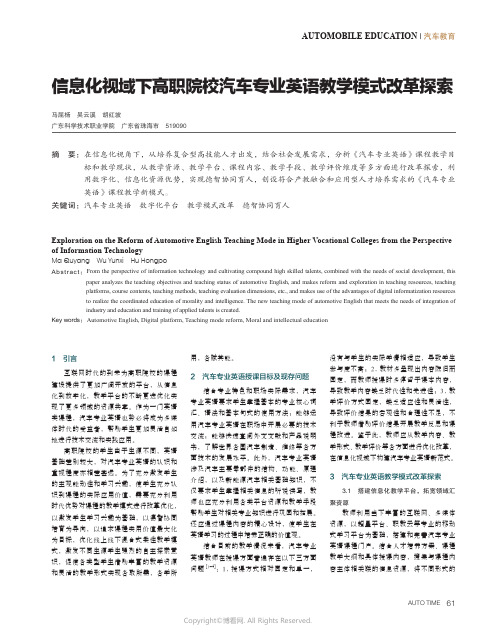
AUTOMOBILE EDUCATION | 汽车教育信息化视域下高职院校汽车专业英语教学模式改革探索马屈杨 吴云溪 胡红坡广东科学技术职业学院 广东省珠海市 519090摘 要: 在信息化视角下,从培养复合型高技能人才出发,结合社会发展需求,分析《汽车专业英语》课程教学目标和教学现状,从教学资源、教学平台、课程内容、教学手段、教学评价维度等多方面进行改革探索,利用数字化、信息化资源优势,实现德智协同育人,创设符合产教融合和应用型人才培养需求的《汽车专业英语》课程教学新模式。
关键词:汽车专业英语 数字化平台 教学模式改革 德智协同育人1 引言互联网时代的到来为高职院校的课程建设提供了更加广阔开放的平台,从信息化到数字化,教学平台的不断更迭优化实现了更多领域的资源共享。
作为一门英语类课程,汽车专业英语也势必将成为多媒体时代的受益者,帮助学生更加灵活自如地进行技术交流和实践应用。
高职院校的学生由于生源不同,英语基础差别较大,对汽车专业英语的认识和重视程度亦相差甚远。
为了充分激发学生的主观能动性和学习兴趣,使学生充分认识到课程的实际应用价值,需要充分利用时代优势对课程的教学模式进行改革优化,以激发学生学习兴趣为基础,以德智协同培育为导向,以追求课程实用价值最大化为目标,优化线上线下混合式柔性教学模式,激发不同生源学生强烈的自主探索意识,促使各类型学生借助丰富的教学资源和灵活的教学形式实现各取所需,各学所用,各赋其能。
2 汽车专业英语授课目标及现存问题结合专业特色和职场实际需求,汽车专业英语要求学生掌握基本的专业核心词汇、语法和基本句式的使用方法;能够运用汽车专业英语在职场中开展必要的技术交流;能够快速查阅外文文献和产品说明书,了解世界各国汽车制造、维修等各方面技术的发展水平。
此外,汽车专业英语涉及汽车主要零部件的结构、功能、原理介绍,以及新能源汽车相关基础知识,不仅要求学生掌握相关信息的听说读写,教师也应充分利用各类平台资源和教学手段帮助学生对相关专业知识进行巩固和拓展。
汽车什么时候被发明的英语作文
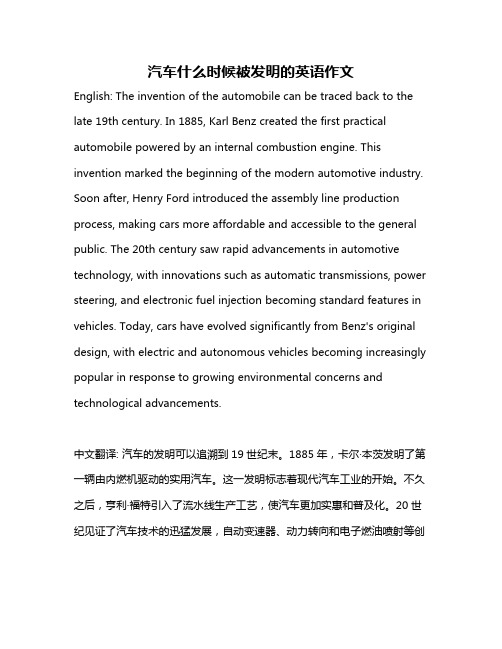
汽车什么时候被发明的英语作文English: The invention of the automobile can be traced back to the late 19th century. In 1885, Karl Benz created the first practical automobile powered by an internal combustion engine. This invention marked the beginning of the modern automotive industry. Soon after, Henry Ford introduced the assembly line production process, making cars more affordable and accessible to the general public. The 20th century saw rapid advancements in automotive technology, with innovations such as automatic transmissions, power steering, and electronic fuel injection becoming standard features in vehicles. Today, cars have evolved significantly from Benz's original design, with electric and autonomous vehicles becoming increasingly popular in response to growing environmental concerns and technological advancements.中文翻译: 汽车的发明可以追溯到19世纪末。
汽车英语翻译
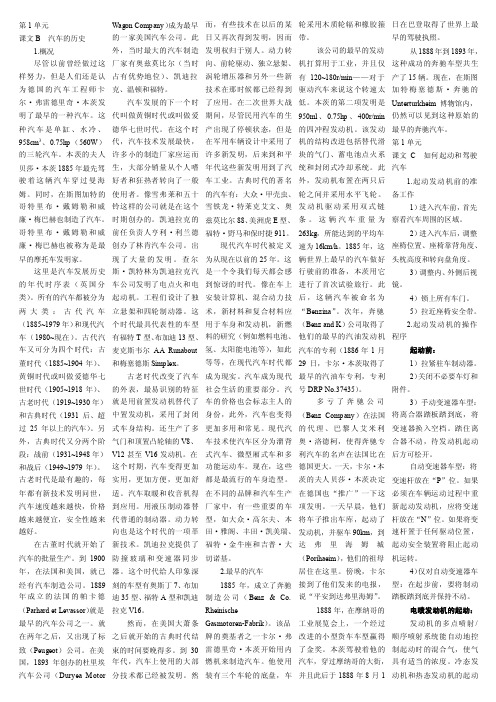
第1单元课文B 汽车的历史1.概况尽管以前曾经做过这样努力,但是人们还是认为德国的汽车工程师卡尔²弗雷德里奇²本茨发明了最早的一种汽车。
这种汽车是单缸、水冷、958cm3、0.75hp(560W)的三轮汽车。
本茨的夫人贝莎²本茨1885年最先驾驶着这辆汽车穿过曼海姆。
同时,在斯图加特的哥特里布²戴姆勒和威廉²梅巴赫也制造了汽车。
哥特里布²戴姆勒和威廉²梅巴赫也被称为是最早的摩托车发明家。
这里是汽车发展历史的年代时序表(英国分类)。
所有的汽车都被分为两大类:古代汽车(1885~1979年)和现代汽车(1980~现在)。
古代汽车又可分为四个时代:古董时代(1885~1904年)、黄铜时代或叫做爱德华七世时代(1905~1918年)、古老时代(1919~1930年)和古典时代(1931后、超过25年以上的汽车)。
另外,古典时代又分两个阶段:战前(1931~1948年)和战后(1949~1979年)。
古老时代是最有趣的,每年都有新技术发明问世,汽车速度越来越快,价格越来越便宜,安全性越来越好。
在古董时代就开始了汽车的批量生产。
到1900年,在法国和美国,就已经有汽车制造公司。
1889年成立的法国的帕卡德(Parhard et Levassor)就是最早的汽车公司之一。
就在两年之后,又出现了标致(Peugeot)公司。
在美国,1893年创办的杜里埃汽车公司(Duryea Motor Wagon Company)成为最早的一家美国汽车公司。
此外,当时最大的汽车制造厂家有奥兹莫比尔(当时占有优势地位)、凯迪拉克、温顿和福特。
汽车发展的下一个时代叫做黄铜时代或叫做爱德华七世时代。
在这个时代,汽车技术发展最快,许多小的制造厂家应运而生,大部分销量从个人嗜好者和狂热者转向了一般使用者。
像雪弗莱和五十铃这样的公司就是在这个时期创办的。
凯迪拉克的前任负责人亨利²利兰德创办了林肯汽车公司。
cars翻译
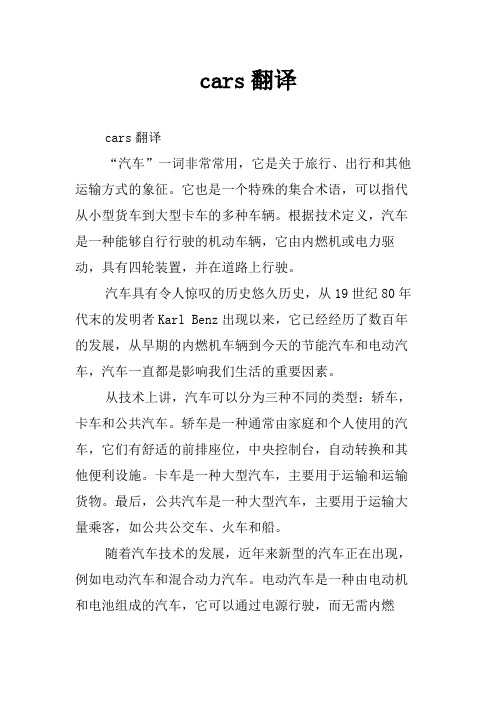
cars翻译
cars翻译
“汽车”一词非常常用,它是关于旅行、出行和其他运输方式的象征。
它也是一个特殊的集合术语,可以指代从小型货车到大型卡车的多种车辆。
根据技术定义,汽车是一种能够自行行驶的机动车辆,它由内燃机或电力驱动,具有四轮装置,并在道路上行驶。
汽车具有令人惊叹的历史悠久历史,从19世纪80年代末的发明者Karl Benz出现以来,它已经经历了数百年的发展,从早期的内燃机车辆到今天的节能汽车和电动汽车,汽车一直都是影响我们生活的重要因素。
从技术上讲,汽车可以分为三种不同的类型:轿车,卡车和公共汽车。
轿车是一种通常由家庭和个人使用的汽车,它们有舒适的前排座位,中央控制台,自动转换和其他便利设施。
卡车是一种大型汽车,主要用于运输和运输货物。
最后,公共汽车是一种大型汽车,主要用于运输大量乘客,如公共公交车、火车和船。
随着汽车技术的发展,近年来新型的汽车正在出现,例如电动汽车和混合动力汽车。
电动汽车是一种由电动机和电池组成的汽车,它可以通过电源行驶,而无需内燃
机。
混合动力汽车是一种配备有内燃机和电动机的汽车,它可以从电池和内燃机中获得动力,从而提高燃料效率。
总之,汽车是一种机动车辆,它具有四轮装置,由内燃机或电力驱动,可以自行行驶,它可以被分为轿车、卡车和公共汽车等不同类型。
近年来,随着新技术的出现,汽车发展变得更加多样化,其中包括电动汽车和混合动力汽车。
汽车不仅仅是一种交通工具,它也是影响我们日常生活的重要因素。
汽车实用英语(一)自学考试大纲
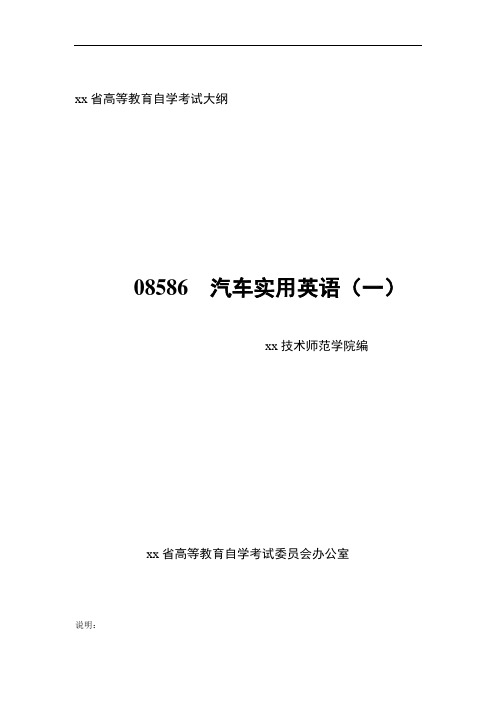
xx省高等教育自学考试大纲08586汽车实用英语(一)xx技术师范学院编xx省高等教育自学考试委员会办公室说明:采用教材:《汽车实用英语》,韩建保编著,高等教育出版社,2009年。
参考文献:《实用汽车维修英语》,王锦俞邹军新编,机械工业出版社,2004年9月第1版。
一、考试的重点内容Unit1 History and Basic Components of Automotives(第一单元汽车发展简史及其基本组成部件)1.掌握汽车各总成及其主要部件的英文词汇和短语;2.掌握描述系统的安装位置和组成部件的句型;3.能够用简单的英文语句描述汽车各系统的基本功能和工作原理。
Unit2 Challenges for Repair Shops from Car’s Innovative Features(第二单元轿车新技术特征对检测维修工作的挑战)1.掌握轿车新技术特征和故障诊断与维修方面的英文词汇和短语;2.熟悉车型的命名惯例;3.能够用简单的英文语句描述轿车新技术特征。
Unit3 Automotive Diagnostic and Test Procedures(第三单元汽车故障诊断与检测方法)1.掌握汽车故障诊断与检测方法方面的英文词汇和短语;2.掌握汽车故障诊断过程主要工作内容的英文语句;3.掌握描述简单故障的英文语句。
Unit4 Years of Automotive Tools(第四单元汽车维修工具的百年发展史)1.掌握汽车维修工具的英文词汇和短语;2.掌握描述汽车维修工具的工作原理和进行各种调整操作的句型。
Unit5 Automobile Electrical Systems and Preventive Maintenance(第五单元汽车电气系统及其预防性维护保养)1.掌握汽车电气系统的英文名称以及故障现象和维护保养方面的英文词汇和短语;2.能够用简单的英文语句描述电气系统的故障现象。
Unit6 Electronic Throttle Control and its noteworthy capabilities(第六单元电子节气门控制及其主要优点)1.掌握汽车电子节气门的基本组成部件的英文词汇和短语;2.能够用简单的英文语句描述汽车电子节气门的功能。
交通工具的演变英文作文
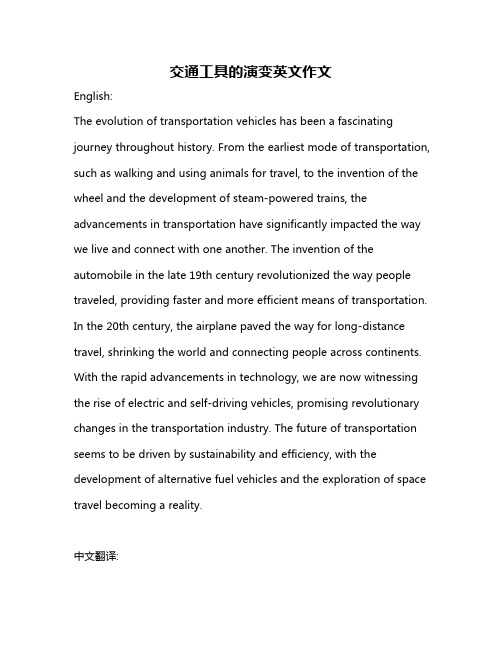
交通工具的演变英文作文English:The evolution of transportation vehicles has been a fascinating journey throughout history. From the earliest mode of transportation, such as walking and using animals for travel, to the invention of the wheel and the development of steam-powered trains, the advancements in transportation have significantly impacted the way we live and connect with one another. The invention of the automobile in the late 19th century revolutionized the way people traveled, providing faster and more efficient means of transportation. In the 20th century, the airplane paved the way for long-distance travel, shrinking the world and connecting people across continents. With the rapid advancements in technology, we are now witnessing the rise of electric and self-driving vehicles, promising revolutionary changes in the transportation industry. The future of transportation seems to be driven by sustainability and efficiency, with the development of alternative fuel vehicles and the exploration of space travel becoming a reality.中文翻译:交通工具的演变历经了一个充满魅力的历史长征。
汽车历史常识

汽车历史常识English:The history of the automobile dates back to the late 19th century, when various inventors and engineers began experimenting with steam-powered vehicles. However, it was the internal combustion engine that revolutionized the automotive industry. Karl Benz, a German engineer, is credited with building the first practical automobile powered by an internal combustion engine in 1885. Since then, the automobile has evolved significantly, undergoing numerous technological advancements and design innovations. The 20th century saw the rise of mass production, which made cars affordable for the average consumer. Today, the automotive industry is a global enterprise, encompassing a wide range of vehicles, from electric cars to autonomous vehicles, all of which continue to shape our modern world.中文:汽车的历史可以追溯到19世纪末,当时众多发明家和工程师开始试验蒸汽动力汽车。
汽车历史的简单介绍英语作文
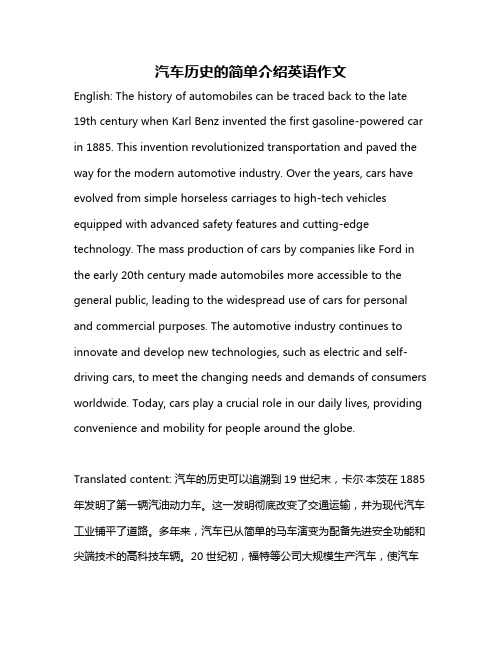
汽车历史的简单介绍英语作文English: The history of automobiles can be traced back to the late19th century when Karl Benz invented the first gasoline-powered car in 1885. This invention revolutionized transportation and paved the way for the modern automotive industry. Over the years, cars have evolved from simple horseless carriages to high-tech vehicles equipped with advanced safety features and cutting-edge technology. The mass production of cars by companies like Ford in the early 20th century made automobiles more accessible to the general public, leading to the widespread use of cars for personal and commercial purposes. The automotive industry continues to innovate and develop new technologies, such as electric and self-driving cars, to meet the changing needs and demands of consumers worldwide. Today, cars play a crucial role in our daily lives, providing convenience and mobility for people around the globe.Translated content: 汽车的历史可以追溯到19世纪末,卡尔·本茨在1885年发明了第一辆汽油动力车。
汽车发展历史的有关介绍英语作文
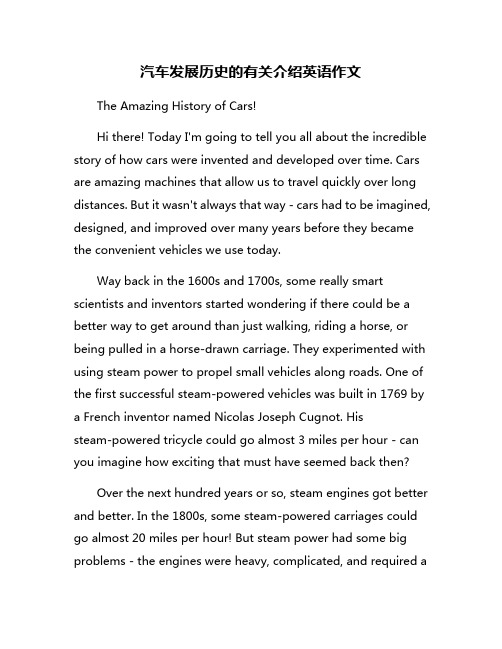
汽车发展历史的有关介绍英语作文The Amazing History of Cars!Hi there! Today I'm going to tell you all about the incredible story of how cars were invented and developed over time. Cars are amazing machines that allow us to travel quickly over long distances. But it wasn't always that way - cars had to be imagined, designed, and improved over many years before they became the convenient vehicles we use today.Way back in the 1600s and 1700s, some really smart scientists and inventors started wondering if there could be a better way to get around than just walking, riding a horse, or being pulled in a horse-drawn carriage. They experimented with using steam power to propel small vehicles along roads. One of the first successful steam-powered vehicles was built in 1769 by a French inventor named Nicolas Joseph Cugnot. Hissteam-powered tricycle could go almost 3 miles per hour - can you imagine how exciting that must have seemed back then?Over the next hundred years or so, steam engines got better and better. In the 1800s, some steam-powered carriages could go almost 20 miles per hour! But steam power had some big problems - the engines were heavy, complicated, and required alot of water and fuel. Plus they released a ton of smoke and were pretty loud. Scientists realized they needed to find a new way to power vehicles.That's when some geniuses started experimenting with gasoline engines! The first gasoline-powered automobile is credited to two German inventors named Karl Benz and Gottlieb Daimler in the 1880s. Their early "horseless carriages" were three-wheeled vehicles powered by a small gasoline engine. Not long after, in 1893, Brothers Charles and Frank Duryea built and road-tested the first successful gasoline-powered car in the United States.From those early inventions, cars just got bigger, better, and faster year after year. An American named Henry Ford realized that cars could be manufactured much more efficiently using something called an assembly line. In 1908, his company started mass-producing a simple, affordable car called the Model T. Suddenly, cars weren't just for the rich anymore - ordinary people could buy them too! Over 15 million Model Ts were made over the next 19 years.As the 1900s went on, cars got cooler styles and more powerful engines. Electric starters were added so you didn't have to crank the engine by hand. Closed metal bodies replaced opencarriage-styles. Luxury features like radios and heaters became available too. Automakers were always competing to make their cars faster, sleeker, and loaded with the latest gadgets.Of course, cars also got much safer over time. Things we take for granted today like seatbelts, airbags, crumple zones, and anti-lock brakes were all invented to help prevent injuries in crashes. Environmental concerns led to more fuel-efficient engines and emissions controls as well.Today's cars are technological marvels compared to those early "horseless carriages." Many run on electricity or hybrid gas-electric systems instead of gasoline alone. Some drive themselves using sensors and computers! Cars allow us to travel in comfort and safety at high speeds across cities, states, and even countries. Without the pioneering work of those inventors and engineers from long ago, we wouldn't have the amazing automobiles we enjoy today.I hope you found this look at the history and development of cars to be interesting! From steam to gasoline to electric power, it's been an incredible journey of creativity and innovation getting cars to where they are now. Who knows what amazing car technologies might be just around the corner? I can't wait to see what drivers will be cruising around in 100 years from now!。
德国汽车发展史
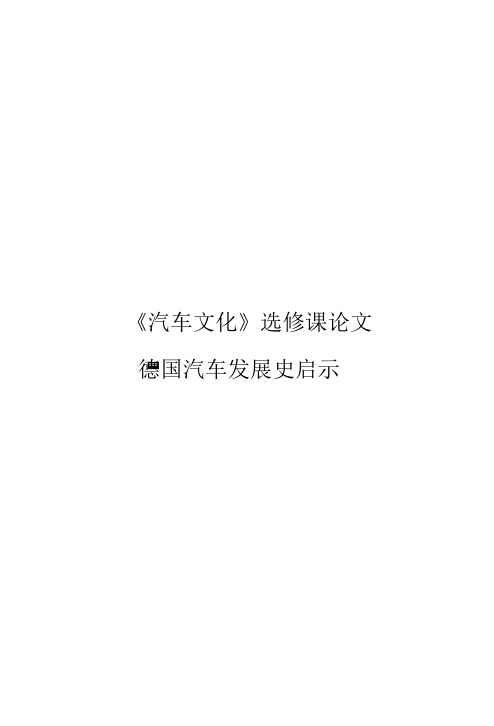
《汽车文化》选修课论文德国汽车发展史---- 大众汽车发展史的启示在历史的长河中,汽车的发展一直是人们最喜欢探究的话题,几乎无论是哪个国家都有一段关于汽车的历史,而最为悠久的要数德国了。
德国是现代汽车的发祥地,是生产汽车历史最悠久的国家。
自从1886年卡尔一本茨发明第一辆汽车至今,德国的汽车工业已经走过了120多年的发展历程。
作为德国生产量最大的大众汽车是怎样逐渐的发展到如今的呢?在它成长的过程中遇到挫折,是怎样克服的?大众的发展离不开德国政府,大众抓住政府给的有利政策和支持快速发展起来。
1932年由德国政府采取一些步骤减轻驾驶汽车方面的税收,目的是降低拥有汽车的开销并刺激汽车的销售。
1933年1 月30日,希特勒上台并建立了一个国家至上的政府。
他要使“平民汽车”的概念成为他自己的论点。
1934年1月17日,波尔舍向德国政府提出一份为大众设计生产汽车的建议书,此项建议得到了希特勒政府的批准和支持。
波尔舍随后组建了一个由34万人入股的大众汽车股份公司在沃尔斯堡的“大众汽车城”里,第一批“甲壳虫”汽车问世, 但仅仅生产了630辆就因第二次世界大战而停产。
二战后,大众公司划归西德政府,汽车生产逐步恢复。
由于“甲壳虫”车价格低廉,很快风靡德国和欧洲,1955年"甲壳虫”汽车出口到100多个国家,并一直生产至今。
其实,从大众的发展中可以看出政府的支持,对一个企业成立及兴衰成败起着关键作用。
一个企业的成功离不开政府,如果政府不支持而且竭力打压,那么一个刚起步的企业是不可能存活下去,更谈不上很好的发展和经营成功了。
不仅仅是企业,就如大众得到政府的支持一样,我们每个人在现实生活中都会遇到对我们有利的环境,当对我们有利的机会来临时,我们一定要好好把握时机,发挥自己应有的能力好好展示和实现自己。
有些机会是难得的,成功的人懂得把握机会,失败的人总是等待机会;当看到成功时不应沉浸在成功的喜悦中, 应该更加努力,使自己变得更成功。
现代汽车发展史外文翻译

The phylogeny of modern carsJohn D.WilliamsAlthough the blueprint for the modern automobile was perfected in Germany and France in the late 1800s, Americans dominated the industry in the first half of the twentieth century. Henry Ford innovated mass-production techniques that became standard, with Ford, General Motors and Chrysler emerging as the “Big Three” auto companies by the 1920s. Manufacturers funneled their resources to the military during World War II, and afterward automobile production in Europe and Japan soared to meet demand. Once vital to the expansion of American urban centers, the industry had become a shared global enterprise with the rise of Japan as the leading automaker by 1980.Although the automobile was to have its greatest social and economic impact in the United States, it was initially perfected in Germany and France toward the end of the nineteenth century by such men as Nicolaus Otto, Gottlieb Daimler, Carl Benz, and Emile Levassor.The 1901 Mercedes, designed by Wilhelm Maybach for Daimler Motoren Gesellschaft, deserves credit for being the first modern motorcar in all essentials. Its thirty-five-horsepower engine weighed only fourteen pounds per horsepower, and it achieved a speed of fifty-three miles per hour. But as late as 1909, with the most integrated automobile factory in Europe, Daimler employed some seventeen hundred workers to produce fewer than a thousand cars per year.Nothing illustrates the superiority of European design better than the sharp contrast between th is first Mercedes model and Ransom E. Olds’s 1901-1906one-cylinder, three-horsepower, tiller-steered, curved-dash Oldsmobile, which was merely a motorized horse buggy. But the Olds sold for only $650, putting it within reach of middle-class Americans, and the 1904 Olds output of 5,508 units surpassed any car production previously accomplished. The central problem of automotive technology over the first decade of the twentieth century would be reconciling the advanced design of the 1901 Mercedes with the moderate price and low operatingexpenses of the Olds. This would be overwhelmingly an American achievement.Bicycle mechanics J. Frank and Charles E. Duryea of Springfield, Massachusetts, had designed the first successful American gasoline automobile in 1893, then won the first American automobile race in 1895, and went on to make the first sale of an American-made gasoline car the next year. Thirty American manufacturers produced 2,500 motor vehicles in 1899, and some 485 companies entered the business in the next decade. In 1908 Henry Ford introduced theModel T and William C. Durant founded General Motors.The new firms operated in an unprecedented seller’s market for an expensive consumer goods item. With its vast land area and a hinterland of scattered and isolated settlements, the United States had a far greater need for automotive transportation than the nations of Europe. Great demand was ensured, too, by a significantly higher per capita income and more equitable income distribution than in European countries.Given the American manufacturing tradition, it was also inevitable that cars would be produced in larger volume at lower prices than in Europe. The absence of tariff barriers between the states encouraged sales over a wide geographic area. Cheap raw materials and a chronic shortage of skilled labor early encouraged the mechanization of industrial processes in the United States. This in turn required the standardization of products and resulted in the volume production of such commodities as firearms, sewing machines, bicycles, and many other items. In 1913, the United States produced some 485,000 of the world total of 606,124 motor vehicles.The Ford Motor Company greatly outpaced its competitors in reconcilingstate-of-the-art design with moderate price. Cycle and Automobile Trade Journal called the four-cylinder, fifteen-horsepower, $600 Ford Model N (1906-1907) “the very first instance of a low-cost motorcar driven by a gas engine having cylinders enough to give the shaft a turning impulse in each shaft turn which is well built and offered in large numbers.” Deluged with orders, Ford installed improved production equipment and after 1906 was able to make deliveries of a hundred cars a day. Encouraged by the success of the Model N, Henry Ford was determined to build an even better “car for the great multitude.” The four-cylinder, twenty-horsepowerModel T, first offered in October 1908, sold for $825. Its two-speed planetary transmission made it easy to drive, and features such as its detachable cylinder head made it easy to repair. Its high chassis was designed to clear the bumps in rural roads. Vanadium steel made the Model T a lighter and tougher car, and new methods of casting parts (especially block casting of the engine) helped keep the price down.Committed to large-volume production of the Model T, Ford innovated modern mass production techniques at his new Highland Park, Michigan, plant, which opened in 1910 (although he did not introduce the moving assembly line until 1913-1914). The Model T runabout sold for $575 in 1912, less than the average annual wage in the United States. By the time the Model T was withdrawn from production in 1927, its price had been reduced to $290 for the coupe, 15 million units had been sold, and mas s personal “automobility” had become a reality.Ford’s mass production techniques were quickly adopted by other American automobile manufacturers. (European automakers did not begin to use them until the 1930s.) The heavier outlays of capital and larger volume of sales that this necessitated ended the era of easy entry and free-wheeling competition among many small producers in the American industry. The number of active automobile manufacturers dropped from 253 in 1908 to only 44 in 1929, with about 80 per cent of the industry’s output accounted for by Ford, General Motors, and Chrysler, formed from Maxwell in 1925 by Walter P. Chrysler. Most of the remaining independents were wiped out in the Great Depression, with Nash, Hudson, Studebaker, and Packard hanging on only to collapse in the post-World War II period.Sports car is an automobile designed more for performance than for carrying passengers or luggage. Sports cars are known for their light weight, speed, nimble handling, and appearance. They feature special equipment, and with few exceptions manufacturers make only limited numbers of them. As a result, pound for pound they cost more than most other cars. Famous sports cars include the Chevrolet Corvette of the United States, the Alfa –Romeo and Ferrari of Italy, the Jaguar XK-E, MGB, and Triumph TR-7 of the United Kingdom, the Porsche 911 and Mercedes 300 SL of Germany, and the Mazda Miata and Nissan 370ZX of Japan.CharacteristicsMost sports cars are two-seaters with low ground clearance and aerodynamic designs that enable them to cut through the air easily. With generally favorable power to weight ratios, these cars often accelerate more quickly than other automobiles do. Sports cars have performance tires and advanced suspension systems. Sports cars often serve as a means of testing new automotive technology before it becomes commonplace in everyday vehicles. For example, automakers have used sports cars to demonstrate the efficiencies of multi-valve, overhead cam engine designs, rack and pinion steering, and four wheel disc brakes before they were incorporated in inexpensive passenger cars.HistoryAutomobiles began to be driven as sporting vehicles in the late 1800's. At that time, rich enthusiasts started racing one another on public roads from town to town. The first formally organized race took place in France in 1895. This race and others like it helped encourage the development of the automobile, and soon special cars were being built for racing. Automobiles in the United States in the early 1900's were light, rugged, and powerful. Well-known models of the time included theHayes-Apperson “Jack Rabbit,” Chadwick Great Six, the Lozier Briarcliff, the Mercer Type 35 Raceabout, and the Stutz Bearcat. As time went by, however, the size of cars increased.By the 1930's, the only sports cars made in the United States were the Auburn, Cord, and Duesenberg, and the same company made all three.By the 1940's, open wheel and stock car racing had become the most popular motor sport in the United States. But in the late 1940's and early 1950's, there was a revival of interest in light, quick cars. A number of small, short-lived businesses sprang up to produce sports cars—among them the Kaiser Darrin and the Crosley Hot-Shot. Meanwhile, sports car production was fairly strong in Europe before and after World War II (1939-1945). Among the most important sports cars manufactured in the United Kingdom were the MG, Austin-Healey, and Triumph. Beginning in the late 1940's, such names as Jaguar of the United Kingdom, Ferrari and Alfa Romeo of Italy, and Porsche of Germany became well-known for racing and sports cars. These cars were discovered by American G.I.s stationed in Europe after the war, andbrought back to the United States. Soon local sports car clubs were established, and cars were raced on a few road courses like Watkins Glen in New York and on former airports, like Sebring in Florida.American manufacturers soon responded to the appearance of European sports cars on American shores. In 1953, the General Motors Corporation launched the Corvette. The Ford Motor Company responded with more luxurious Thunderbird in 1954, but Ford eventually turned the "T-bird" into a four-seater. Thus, the Corvette remained the only true sports car made in the United States until the Chrysler Corporation introduced the Dodge Viper in 1992.In the 1960's, the Japanese auto industry introduced its first sports cars, including the Honda S800 and Toyota 2000GT. Since then, Japanese automakers have built generations of fast, reliable sports cars. Among these are the Nissan ZX, Toyota MR-2, Mazda RX-7, and Mazda Miata.Since 2000, several automakers have made cars with vastly increased engine power. This increase makes sports cars potentially more dangerous and difficult to control. Fortunately, advanced stability control systems have also become more common. The Audi R8 is typical of the modern sports car, with all-wheel drive and all-aluminum construction.Sports cars continue to be popular among a group of young drives and older drivers who wish to remain feeling young. Often expensive, they bring status and the exhilaration of speed to those who drive them.虽然现代汽车的蓝图展开发生在19世纪后期的德国和法国,在二十世纪上半页美国人主导了该产业。
汽车历史的介绍英语作文
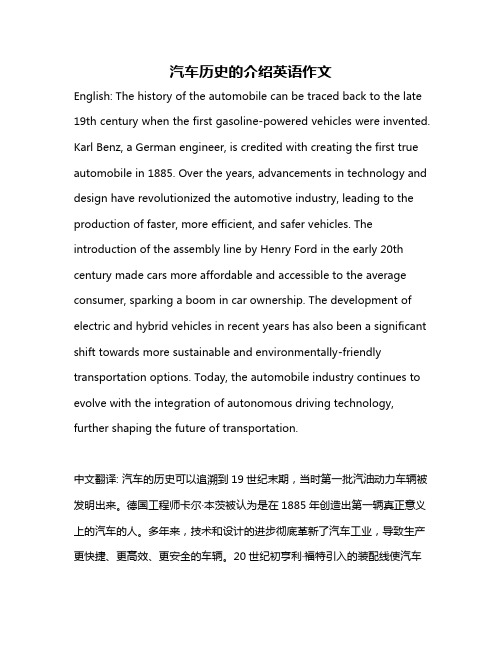
汽车历史的介绍英语作文English: The history of the automobile can be traced back to the late 19th century when the first gasoline-powered vehicles were invented. Karl Benz, a German engineer, is credited with creating the first true automobile in 1885. Over the years, advancements in technology and design have revolutionized the automotive industry, leading to the production of faster, more efficient, and safer vehicles. The introduction of the assembly line by Henry Ford in the early 20th century made cars more affordable and accessible to the average consumer, sparking a boom in car ownership. The development of electric and hybrid vehicles in recent years has also been a significant shift towards more sustainable and environmentally-friendly transportation options. Today, the automobile industry continues to evolve with the integration of autonomous driving technology, further shaping the future of transportation.中文翻译: 汽车的历史可以追溯到19世纪末期,当时第一批汽油动力车辆被发明出来。
汽车发展史-英文翻译
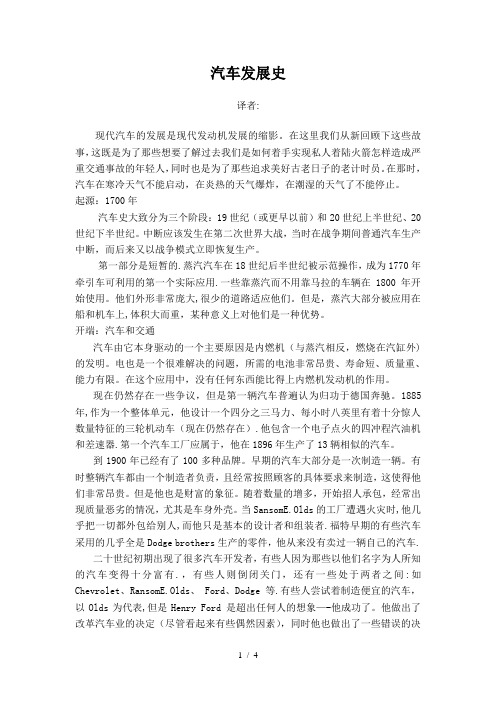
汽车发展史译者:现代汽车的发展是现代发动机发展的缩影。
在这里我们从新回顾下这些故事,这既是为了那些想要了解过去我们是如何着手实现私人着陆火箭怎样造成严重交通事故的年轻人,同时也是为了那些追求美好古老日子的老计时员。
在那时,汽车在寒冷天气不能启动,在炎热的天气爆炸,在潮湿的天气了不能停止。
起源:1700年汽车史大致分为三个阶段:19世纪(或更早以前)和20世纪上半世纪、20世纪下半世纪。
中断应该发生在第二次世界大战,当时在战争期间普通汽车生产中断,而后来又以战争模式立即恢复生产。
第一部分是短暂的.蒸汽汽车在18世纪后半世纪被示范操作,成为1770年牵引车可利用的第一个实际应用.一些靠蒸汽而不用靠马拉的车辆在1800年开始使用。
他们外形非常庞大,很少的道路适应他们。
但是,蒸汽大部分被应用在船和机车上,体积大而重,某种意义上对他们是一种优势。
开端:汽车和交通汽车由它本身驱动的一个主要原因是内燃机(与蒸汽相反,燃烧在汽缸外)的发明。
电也是一个很难解决的问题,所需的电池非常昂贵、寿命短、质量重、能力有限。
在这个应用中,没有任何东西能比得上内燃机发动机的作用。
现在仍然存在一些争议,但是第一辆汽车普遍认为归功于德国奔驰。
1885年,作为一个整体单元,他设计一个四分之三马力、每小时八英里有着十分惊人数量特征的三轮机动车(现在仍然存在).他包含一个电子点火的四冲程汽油机和差速器.第一个汽车工厂应属于,他在1896年生产了13辆相似的汽车。
到1900年已经有了100多种品牌。
早期的汽车大部分是一次制造一辆。
有时整辆汽车都由一个制造者负责,且经常按照顾客的具体要求来制造,这使得他们非常昂贵。
但是他也是财富的象征。
随着数量的增多,开始招人承包,经常出现质量恶劣的情况,尤其是车身外壳。
当SansomE.Olds的工厂遭遇火灾时,他几乎把一切都外包给别人,而他只是基本的设计者和组装者.福特早期的有些汽车采用的几乎全是Dodge brothers生产的零件,他从来没有卖过一辆自己的汽车.二十世纪初期出现了很多汽车开发者,有些人因为那些以他们名字为人所知的汽车变得十分富有.,有些人则倒闭关门,还有一些处于两者之间:如Chevrolet、RansomE.Olds、 Ford、Dodge等.有些人尝试着制造便宜的汽车,以Olds为代表,但是Henry Ford 是超出任何人的想象—-他成功了。
英语作文汽车发展史英语作文
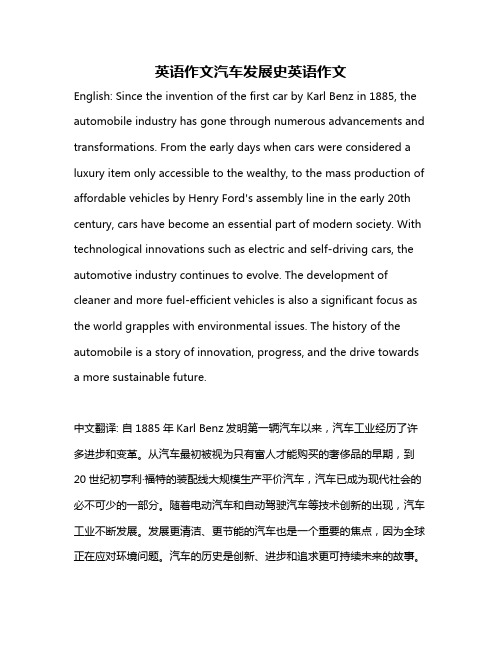
英语作文汽车发展史英语作文English: Since the invention of the first car by Karl Benz in 1885, the automobile industry has gone through numerous advancements and transformations. From the early days when cars were considered a luxury item only accessible to the wealthy, to the mass production of affordable vehicles by Henry Ford's assembly line in the early 20th century, cars have become an essential part of modern society. With technological innovations such as electric and self-driving cars, the automotive industry continues to evolve. The development of cleaner and more fuel-efficient vehicles is also a significant focus as the world grapples with environmental issues. The history of the automobile is a story of innovation, progress, and the drive towards a more sustainable future.中文翻译: 自1885年Karl Benz发明第一辆汽车以来,汽车工业经历了许多进步和变革。
- 1、下载文档前请自行甄别文档内容的完整性,平台不提供额外的编辑、内容补充、找答案等附加服务。
- 2、"仅部分预览"的文档,不可在线预览部分如存在完整性等问题,可反馈申请退款(可完整预览的文档不适用该条件!)。
- 3、如文档侵犯您的权益,请联系客服反馈,我们会尽快为您处理(人工客服工作时间:9:00-18:30)。
汽车发展史译者:现代汽车的发展是现代发动机发展的缩影。
在这里我们从新回顾下这些故事,这既是为了那些想要了解过去我们是如何着手实现私人着陆火箭怎样造成严重交通事故的年轻人,同时也是为了那些追求美好古老日子的老计时员。
在那时,汽车在寒冷天气不能启动,在炎热的天气爆炸,在潮湿的天气了不能停止。
起源:1700年汽车史大致分为三个阶段:19世纪(或更早以前)和20世纪上半世纪、20世纪下半世纪。
中断应该发生在第二次世界大战,当时在战争期间普通汽车生产中断,而后来又以战争模式立即恢复生产。
第一部分是短暂的。
蒸汽汽车在18世纪后半世纪被示范操作,成为1770年牵引车可利用的第一个实际应用。
一些靠蒸汽而不用靠马拉的车辆在1800年开始使用。
他们外形非常庞大,很少的道路适应他们。
但是,蒸汽大部分被应用在船和机车上,体积大而重,某种意义上对他们是一种优势。
开端:汽车和交通汽车由它本身驱动的一个主要原因是内燃机(与蒸汽相反,燃烧在汽缸外)的发明。
电也是一个很难解决的问题,所需的电池非常昂贵、寿命短、质量重、能力有限。
在这个应用中,没有任何东西能比得上内燃机发动机的作用。
现在仍然存在一些争议,但是第一辆汽车普遍认为归功于德国奔驰。
1885年,作为一个整体单元,他设计一个四分之三马力、每小时八英里有着十分惊人数量特征的三轮机动车(现在仍然存在)。
他包含一个电子点火的四冲程汽油机和差速器。
第一个汽车工厂应属于,他在1896年生产了13辆相似的汽车。
到1900年已经有了100多种品牌。
早期的汽车大部分是一次制造一辆。
有时整辆汽车都由一个制造者负责,且经常按照顾客的具体要求来制造,这使得他们非常昂贵。
但是他也是财富的象征。
随着数量的增多,开始招人承包,经常出现质量恶劣的情况,尤其是车身外壳。
当SansomE.Olds的工厂遭遇火灾时,他几乎把一切都外包给别人,而他只是基本的设计者和组装者.福特早期的有些汽车采用的几乎全是Dodge brothers生产的零件,他从来没有卖过一辆自己的汽车。
二十世纪初期出现了很多汽车开发者,有些人因为那些以他们名字为人所知的汽车变得十分富有。
,有些人则倒闭关门,还有一些处于两者之间:如Chevrolet、RansomE.Olds、 Ford、Dodge等。
有些人尝试着制造便宜的汽车,以Olds为代表,但是Henry Ford 是超出任何人的想象——他成功了。
他做出了改革汽车业的决定(尽管看起来有些偶然因素),同时他也做出了一些错误的决定。
他觉得对汽车收费太贵的决定是错误的,是使供需曲线上更为合适的那一点受到打击。
大部分购买者的产品乘以低价格比小部分购买者乘以高价格高得多。
福特的合作伙伴也劝说,福特应该给工人更好的待遇和工资。
他们把日工作时间从九小时降低到八小时,付给的工资几乎是当时普通工资的二倍。
着给予了福特最佳工作动力的最佳选择和工人的忠诚。
至少在一两年是这样。
他创下了每小时91或100英里的速度纪录。
据记载,驾驶自己设计的汽车将要承担很大的风险。
他也要对第一次记载的汽车事故负责,他开车把一位路上的行人给撞飞了。
福特的颠峰成就是在1908年的Modle T。
为了达到他的目标,他不得不降价,并增加效率。
关键是大规模生产同一汽车的组装生产线,他成功掌握了这些。
他可能已经发明了流动组装生产线,这使得工厂开始了“汽车持续向前供应的平稳流水线”。
任何事物都为了这个工序仔细安排。
零件供应者希望在他们使用的零件中,大多数零件是由他们俩提供。
零件供应商要把零件装在一个特制的箱子里,然后用船装运。
这些零件会出现在汽车的适当位置。
T是一个发动机前置后轮驱动的设计,他采用水冷四缸发动机,每小时超出四十英里。
变速器采用行星齿轮,以后可以被替换,但是这只能出现在自动变速器中。
生产线也有他不利的一面。
当生产线流动越来越快时,工人四个接着四个地安装相同的零件,他们开始羡慕农民的自由自在和独立,即使他们的工作负担重、收入少。
这可以说是失去了人性自由。
在福特想要消除认为错误的意义上来说,这的确是真的。
更讽刺的是,第一次大的汽车工业劳动者游行示威是由最开始改善劳动工人命运的福特指导的。
他用武力回应了这个组织,也很快使他们了解了他的手段。
福特打算关闭他的工厂也不愿意承认这个组织,直到他的妻子劝服他采用别的办法。
福特几次降低了Model T的价格,最后降到260美元。
流行畅销的Model T 在20年内卖出了15,000,000辆,比其他任何车型都多。
直到1990年,Volkswagen Beetle打破了这个记录。
但那只持续了半个多世纪的时间。
在有些国家,尤其是在美国上午一些地区,福特成为了汽车的代名词。
福特尝试着享受着长久的这种成功。
他认为如果汽车完成了这个任务,那就没有原因改变这些了。
同时,其他制造者都在提供改进的车型。
通用公司的Sloan提出了有规律地引进新型车,有计划地淘汰的观念。
但福特想到了一个他自己的计谋,他在新车Model A准备好之前终止了Model T的生产。
所有有关Model A的细节全部保密,没有规格说明,没有图片,没有价格,什么都没有。
看来,工业间谍活动还没有流行起来。
这时的中断和猜测创造了一个新型的市场。
当Model A最后出现时他并没有显得很优秀。
虽然如此,经销商在头两周内还是订购了400,000辆。
在天平的另一端,很多人都在尝试着从事汽车制造。
最典型的就是在为已建立的公司工作一段时间后,在工程期间也出现了一些杰作。
在今天的汽车中很少有在第二次世界大战以前没有做过尝试的。
但是在经济上很多公司都失败了。
因为他们没有生产出大量数目的汽车或者有的在生意上花费了太多的时间。
事实上,有惊人数目的汽车公司从未真正卖出过一辆汽车。
这种消沉使很多人打了退堂鼓。
现在我们看到的品牌数量也许令人眼花缭乱,但是他与那些不存在的品牌数量来说是很少的。
汽车全集百科全书列出了300多种在字母A下独立的牌子。
汽车很快就改变了美国的风景,他们填充了城市的每一个空间。
高速公路上建立起了汽车旅馆。
福特和他的朋友Harvey Firestone及Thomas Edison开辟了汽车驾驶度假。
1913年,Gulf Refining公司建立了第一个加油站。
以前汽车驾驶员必须开车到铁路站并从一个大容量的汽车中加油。
政府并不支持这项突出的发明,他们认为这是另人讨厌的事情,设法用高税收和地速度限制来阻止。
糟糕的工艺设计故意被采用来避免严格的规章。
但是这种观念太强大了,以至于不能被扼杀。
第二次世界大战:普通的汽车生产在国家进入第二次世界大战后终止了一段时间。
所有的工业转向于制造战争材料,甚至保证现存汽车运行的替代部分有时也不能用。
汽油的使用有限,但是一旦你需要额外的,你必须从别人手中购买。
自由市场继续当成黑市。
轮胎是汽车磨损最快的部分,当是轮胎已经几乎不能使用,但是他们采用内管,如果轮胎的磨损过于严重以至于不能容纳管子,就可以利用特制的管子来堵住洞口。
出现这种问题主要是从东方国家来的天然橡胶的供应被日本中途阻止,这使合成橡胶得到发展,也使情况有所好转。
第二次世界大战最著名的交通工具是军队的全方位目的工具,缩写为GP,发音为吉普。
现在已经注册商标。
1939年,军队开始探索轻质量、坚固、实用的交通工具。
第一个成功的模型是Bantam建造的。
但是合同却授给了Willys-Overland的公司。
由于福特也在强制许可下生产了汽车,最终产量是660,000辆。
其中有四轮驱动,他因为能在其他任何东西不能工作是消除脏污而著名。
除了四轮定位的复杂之处,他就变得简单了,并且坚固耐用。
如果解冻器不能随着雪的大小发挥作用,且在大多数时间都如此,你可以拆开车的顶部,把挡风板折叠起来,然后继续工作。
在某段时间,吉普被用来表示任何的四轮驱动车。
一个异常不和规则的情况是美国盛行的邮政吉普是二轮驱动。
中间的发展阶段我们先不细谈,下面我们来看一下2000年甚至更晚一些的汽车发展。
在历史上,对未来的美好的预想几乎都没有实现,大多数都是错误的,最好的情况是维持现状。
突破是存在这种可能的,但是我们不应该把全部的砝码都压在他的上面。
一个制造商提到假设极力设想下我们被鼓励行驶汽车,那么驶过后的空气净化的问题怎么样解决,因为新在的空气太脏了(一个相同的问题也会发生在水上,他们被吸收后排出污物。
目前,我们确实有一些潜在的不可限量能源:太阳能。
如果我们能发明一种成本低、高效率的仪器来利用太阳的辐射,且最好是直接产生电能、核裂变,这需要更高的技术突破;核分裂是政治问题,而不是技术问题。
然后我们能使用电动汽车,但前提是我们能解决电池能量的问题。
或者我们能把水分离成氢和氧,在设计出能够实用气体存贮系统,这样我们可以有放射是无害的一个更加强有力的集成电路引擎。
有个言语诙谐的人说:"电动汽车是汽车的未来,并且持续百年"。
在一段时间内,内燃机以某种形式遍及四方,且不断地改善。
再次从历史上来说,大部分预测的障碍已经被打破。
我们已经了解到用新车代替现存的车辆是一种负面的进步。
因为在生产全部必要材料过程中招致的污染要比旧车排出的更严重。
而且,花销将会在那些能切实减小污染的东西上。
看来IC汽车的将来不是被工程决定着,也非经济,而是以政治。
过去,立法者经常在灾难性结果前试着取消有关自然的法律,毫无疑问他将不会在发生。
资料来源:Arthur D. Delagrange.The Automobile From Horseless Carriage to Everyday Technology [N].SPRING,2001.。
